Media | Articles
Integra gets a manual option, Moke goes electric, Prodrive goes rallying with alternative fuel
Acura’s all-new Integra gets a row-your-own option
Intake: Ahead of the unveiling of Acura’s all-new Integra next year, the marque has revealed that it can be optioned with a six-speed manual transmission. Huzzah! The return of this heralded nameplate was first announced at Pebble Beach earlier this year via a high-tech drone show, and a teaser image released late last month showed a shadowy silhouette that appears to be a five-door liftback. Although not much else is known about the engineering of the car, we’d expect it to ride on a revised version of Acura’s TLX platform, or perhaps the underpinnings of the 11th-generation Honda Civic, which just arrived in dealer showrooms earlier this summer. As for the gearbox itself, it’s no stretch to imagine most of the driveline components from the Civic Type R finding their way into the Integra.
Exhaust: Consider this your good news of the day. It’s well-known that the manual transmission was a key factor in making the world-famous DC2 Integra—particularly the Type R version—one of the best driving front-wheel-drive cars in history. Knowing that a three-pedal variant will be possible on the new model only heightens our hopes that the Integra can once again become a standard-bearer for engaging driving dynamics. While an automatic gearbox is almost certainly the standard offering, we’ll go on record as saying the manual-equipped model will be the one to get.
Does this 1965 Amphicar float your boat?
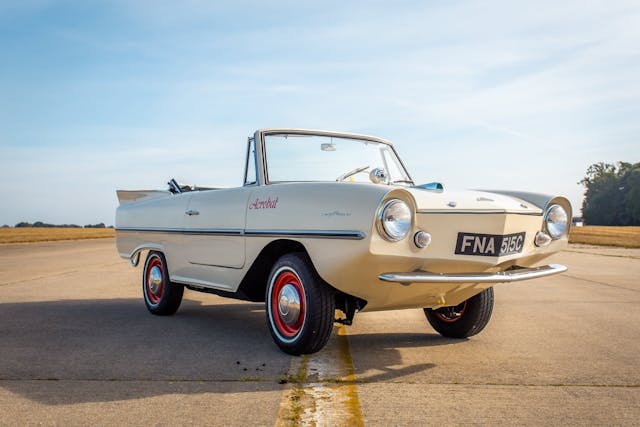
Intake: Do you want to make a splash at your next cars and coffee? Perhaps you’d like to trade the highway for the high seas? Then you’ll want to make a quick bid for this 1965 Amphicar Model 770. It’s been completely restored by Bridge Classic Cars at a cost of over $114,000, converted to run on E10 gasoline, and it even comes with an official Boat Safety Scheme certificate. The electrical systems have wisely been renewed and there are fresh marine-ply floorboards to give the cabin a suitably nautical theme. The seats are marine-specification vinyl as well. The bodywork was taken back to bare metal and fiberglass, and repainted in Beach Strand White. Under the hood is a 45-hp 1147 cc engine from a Triumph Herald which has been rebuilt, as has the suspension and gearbox. The water works include refurbished twin propellors and new bilge pumps. The Amphicar is for sale in the U.K. on Car and Classics and registered for the road in Britain, but it previously resided at California’s Beverly Hills Car Club so there’s no reason it couldn’t be imported again.
Exhaust: Only 4000 Amphicars were made and the very best #1 Concours condition cars are worth $101,000. At the time of writing bidding had reached around $70,000 with just hours to go so this shipshape Amphicar could be a steal.
Celebrate the Oldsmobile Toronado’s 56th Birthday
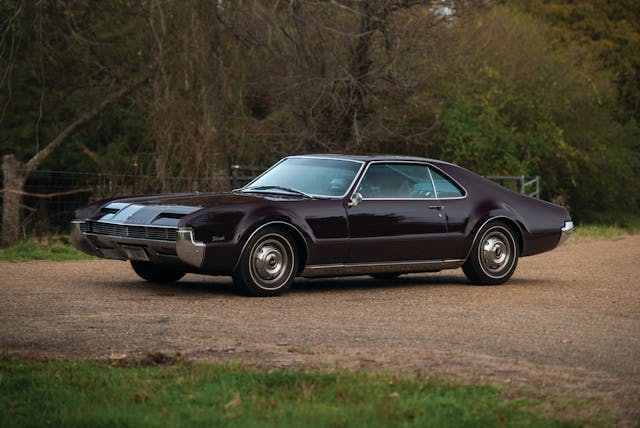
Intake: Fans of advanced engineering and personal luxury have something to celebrate, as the front-wheel-drive Oldsmobile Toronado made its debut on this day 1965. The 1966 Toronado garnered respect for its premium features and radical styling, but it was also the first GM product with a chassis that utilized subframes, and a Unitized Power Package (UPP) consisting of a heavy duty Turbo-Hydramatic 425 transaxle sending power from the Oldsmobile’s Rocket V8 to the front wheels via its “Hy-Vo” chain drive design. This setup was famously reliable and made its way into Cadillacs and even the GMC Motorhome.
Marketplace
Buy and sell classics with confidence
Exhaust: In many ways, the Oldsmobile Toronado was a reincarnation of the legendary Cord 810/812, and not just because of its radical drivetrain layout. It sported a stunning interior design, unique suspension, and even special door hinges that allowed rear seat occupants an easier way out of the Toronado. Well, provided you’d ever want to leave!
Charge around the beachfront with Moke’s new EV
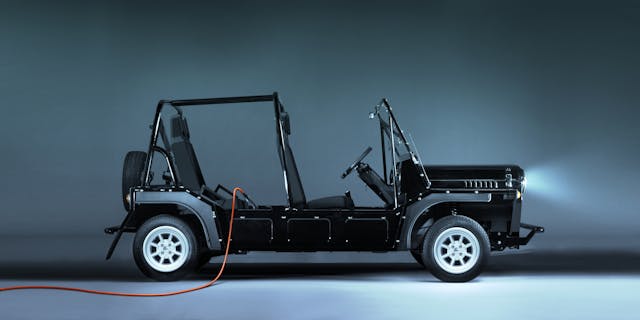
Intake: Your favorite beach car brand has further blurred the line between retirement resort golf cart and classic sandy runabout. Moke International has unveiled its all-electric, well, Moke. Were it not for the cord sticking out of the black car in the photo above, you’d be hard-pressed to realize this is an EV, which in the case of Moke and its iconic shape, is probably a good thing. The new Moke is powered by a three-phase AC synchronous motor turning the rear wheels, and it has a top speed of roughly 62 mph. It can be configured for either right-hand or left-hand drive. Moke claims a range of around 90 miles, and a four hour charge time. As a part of this new vehicle announcement, Moke has also made it known that after January 1, 2022, it will not make any more internal combustion-powered Mokes, technically making it the first legacy manufacturer to go fully electric. Prices for the new EV Moke start just shy of $40,000.
Exhaust: Beach cars are delightful little oddities, and seeing the Moke revamped for service as an EV is fun, if only for a small cohort. While 90 miles may not seem like all that much range, recount how far it is from your cottage to your favorite ice cream store to that perfect place on the waterfront—probably well under 90 miles. Moke does mention that if you still have desires for a gas-powered runabout, the last few units are still available through its official U.K. distributor, the Hendy Group.
Prodrive will e-fuel its Dakar rally car
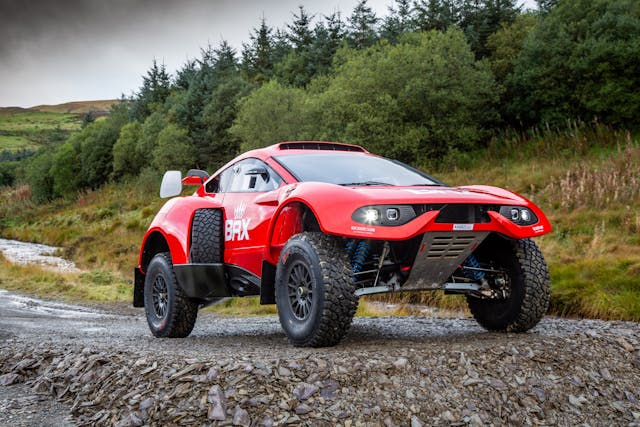
Intake: Prodrive’s Hunter T1+ rally raid car will run on a new sustainable fuel in the FIA World Cup for Cross Country Rallies. The motorsports specialist developed its Prodrive ECOpower gas with fellow British firm Coryton Advanced Fuels and it uses a combination of biofuel manufactured from agricultural waste and e-fuel created using carbon capture technology. Prodrive claims that the net reduction in greenhouse gas emissions from the fuel is 80 percent compared to regular gasoline. “I am a great advocate of motorsport taking the lead in developing, proving and promoting new technologies that can help address climate change,” said Prodrive chairman Dave Richards. “Covering thousands of miles across the toughest terrains, the Dakar and the FIA World Cup for Cross-Country Rallies are the perfect environment to showcase the benefits of the next generation of sustainable fuels and demonstrate that they can be used in road vehicles to reduce the use of fossil fuels, while still offering the same performance and range.” The fuel’s first major test will be the epic Dakar Rally in January 2022 which covers over 4000 miles through the Saudi Arabian desert.
Exhaust: The greening of motorsports is moving at speed. Porsche has confirmed that its Supercup cars will be powered by a new synthetic fuel made at a new facility in Chile, and Formula 1 is to switch to carbon-neutral fuel in 2025. As far as we’re concerned, the quicker the quicker this conversion can happen, the better. Who knows, it might even prove that today’s internal combustion engines still have a lot of living left to do with the help of e-fuel.
Volkswagen’s 2022 Jetta is a fuel sipper
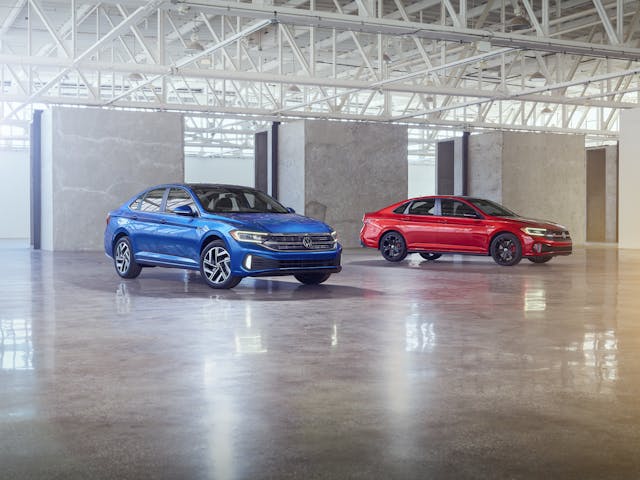
Intake: Volkswagen has released the fuel economy ratings for both the base 1.5-liter turbocharged TSI engine and the 2.0-liter EA888 from the Jetta GLI. Six-speed manual models equipped with the 1.5-liter earn an EPA-estimated 29 mpg city, 43 mpg highway, and 34 mpg combined. Eight-speed auto models return 31/41/35. For the 2.0-liter, the six-speed receives a 26/37/30 mpg rating, and again, the eight-speed drops the highway rating, but still maintains its overall average, with a 26/36/30mpg estimate.
Exhaust: These fuel-sipping numbers from the 1.5-liter are impressive and the combined economy eclipses that of even some Jetta TDI models from years ago. While gasoline engines are surely on their way out—just how long they will take to leave is up for debate—it’s good to see engineers still squeaking out every possible incremental improvement.















